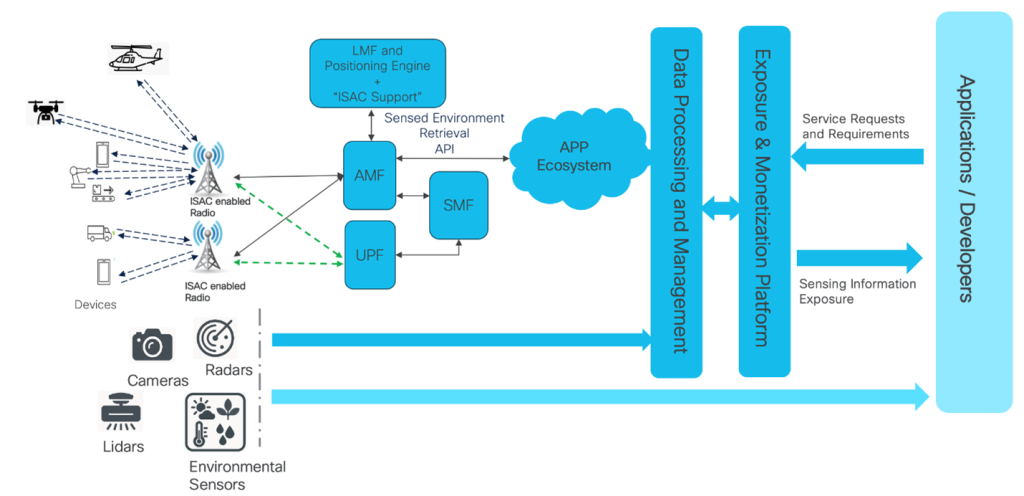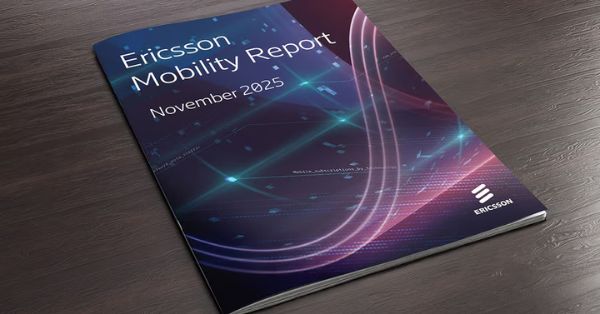In the past two years, wireless infrastructure has undergone some of its most significant transformations since the launch of 5G. Spectrum policy, RAN evolution, and edge computing are reshaping network economics. Now, a new layer is quietly but fundamentally altering what mobile networks can do: Integrated Sensing and Communication, or ISAC.
In our latest white paper, “Transforming Industries with Integrated Sensing and Communication”, 5G Americas explores what ISAC is and what it can do to transform entire industries. While 5G brought the bandwidth and latency necessary for industrial automation and immersive experiences, 6G is poised to add something more foundational: perception. That is what ISAC delivers. It embeds radar-like sensing into cellular infrastructure, enabling networks to interpret their physical environment rather than simply serving it.
And that shift is not just technical. It is strategic.
ISAC allows base stations and user devices to detect and characterize objects without requiring a connection to them. It uses the same radio signals already in play for communication to gather data about position, velocity, and even shape. That means a 6G network equipped with ISAC could simultaneously manage a video stream and track a drone using the same infrastructure.


This dual-use capability is already in focus at standards bodies. Both 3GPP and ITU have placed ISAC among the core pillars of the 6G vision, with work underway in Release 19 and continuing in Releases 20 and 21. The goal is to let communication signals double as sensing tools, minimizing overhead while enabling new capabilities that serve both operational and business needs.
Why does this matter now?
Because networks are no longer just pipes. They are platforms. And platforms that can perceive their environment will be more efficient, more monetizable, and more essential across industries.
Take public safety. ISAC can detect uncrewed aerial vehicles (UAVs) near critical infrastructure without needing them to be connected. In smart factories, it can track automated guided vehicles (AGVs) with real-time motion analytics. In healthcare, it enables fall detection in care facilities without relying on wearable devices. At urban intersections, ISAC-based sensing could improve traffic timing by identifying pedestrians and vehicle types directly from the network’s vantage point.
These are not hypothetical use cases. In fact, the European Telecommunications Standards Institute (ETSI) recently evaluated 18 ISAC scenarios across public safety, transportation, industrial automation, and healthcare. A few stood out in both economic value and technical feasibility. UAV transport safety, disaster monitoring, and sensing-aided communications all rank highly when it comes to commercial potential and societal benefit.
That last case—sensing-aided communications—deserves more attention. Most ISAC discussions center on new services, but sensing can also improve how the network itself performs. For example, environmental data can enhance handovers, beam steering, and spectrum allocation. This makes ISAC not just a feature for external use, but a capability that strengthens core network efficiency and resilience.
It also opens the door to a new revenue model: “Sensing-as-a-Service.” If mobile operators control infrastructure that can perceive the physical world, they can expose those insights to enterprise clients through APIs. This creates opportunities across logistics, autonomous mobility, and immersive applications. It transforms the radio access network into a data platform, one that provides location, motion, and environmental intelligence beyond traditional connectivity.
Of course, there are challenges. Adding sensing to communication systems is not a binary switch. It is a balance. Sensing needs fine time and spatial resolution. Communication needs throughput and reliability. Waveforms built for one are rarely ideal for the other. Combining both on the same hardware creates interference and complexity that must be managed by intelligent control systems at the edge.

That is why waveform design, signal co-existence, and low-power processing are now key research areas. These are not just engineering puzzles. They are business-enabling technologies. Every sensing feature comes with trade-offs in latency, coverage, or system complexity. Networks will need architectures that are modular, adaptive, and capable of serving both purposes without compromise.
Privacy and ethics are equally important. When a network can infer motion, gestures, or behavior, it raises new concerns about transparency and consent. What is permissible in public transportation may not be acceptable in private residential settings. Mobile operators and policymakers will need to develop frameworks that align sensing innovation with social expectations and regulatory safeguards.
A critical question remains. Can we scale this?
The answer will depend on how spectrum is allocated, how hardware evolves, and how well the industry coordinates. Some frequencies—such as mmWave or sub-THz bands—are better suited for high-resolution sensing. But these are unlikely to be widely deployed in the early stages of 6G. At the same time, base station hardware must be capable of processing both sensing and communication signals without compromising either. And without a common set of APIs, KPIs, and test methodologies, deployments will be fragmented and slow to gain traction.
That said, there is momentum. Proofs of concept using commercial 5G hardware have already demonstrated basic ISAC functionality. Vendors, cloud providers, and standards bodies are engaging. If this pace continues, ISAC will become more than a feature of 6G. It may become the organizing logic for how networks deliver value across use cases and industries.
So where does this leave us?
ISAC is not simply about detecting objects. It is about making networks context-aware. Instead of acting as passive data conduits, future mobile networks will interpret, respond, and adapt to the environment around them. That shift changes what networks are and what roles they play across the digital economy.
As we look ahead to the next cycle of investment and standardization, this is the moment to shape the frameworks that will guide ISAC adoption. Technical architecture, economic models, and ethical design will all play a role. And the sooner we align on those priorities, the better positioned we will be to lead.
Because whether the use case is communication, sensing, or both, the future of wireless networks will not be built in isolation from the physical world. It will be built in partnership with it.
By Viet Nguyen, President, 5G Americas – July 2025
Find out more about Integrated Sensing and Communications
The post Sensing Meets Connectivity: A Strategic Shift for Mobile Networks appeared first on 5G Americas.








































